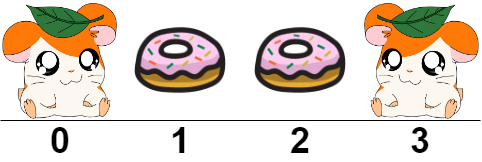2086. Minimum Number of Food Buckets to Feed the Hamsters
Description
You are given a 0-indexed string hamsters where hamsters[i] is either:
'H'indicating that there is a hamster at indexi, or'.'indicating that indexiis empty.
You will add some number of food buckets at the empty indices in order to feed the hamsters. A hamster can be fed if there is at least one food bucket to its left or to its right. More formally, a hamster at index i can be fed if you place a food bucket at index i - 1 and/or at index i + 1.
Return the minimum number of food buckets you should place at empty indices to feed all the hamsters or -1 if it is impossible to feed all of them.
Example 1:

Input: hamsters = "H..H" Output: 2 Explanation: We place two food buckets at indices 1 and 2. It can be shown that if we place only one food bucket, one of the hamsters will not be fed.
Example 2:

Input: hamsters = ".H.H." Output: 1 Explanation: We place one food bucket at index 2.
Example 3:

Input: hamsters = ".HHH." Output: -1 Explanation: If we place a food bucket at every empty index as shown, the hamster at index 2 will not be able to eat.
Constraints:
1 <= hamsters.length <= 105hamsters[i]is either'H'or'.'.
Solutions
Solution: Greedy
- Time complexity: O(n)
- Space complexity: O(n)
JavaScript
js
/**
* @param {string} hamsters
* @return {number}
*/
const minimumBuckets = function (hamsters) {
const isCanFeed = value => value === '.' || value === 'F';
let result = 0;
hamsters = hamsters.split('');
for (let index = 0; index < hamsters.length; index++) {
if (hamsters[index] !== 'H') continue;
const previous = hamsters[index - 1];
const next = hamsters[index + 1];
if (!isCanFeed(previous) && !isCanFeed(next)) return -1;
if (previous === 'F') continue;
if (next === '.') hamsters[index + 1] = 'F';
result += 1;
}
return result;
};